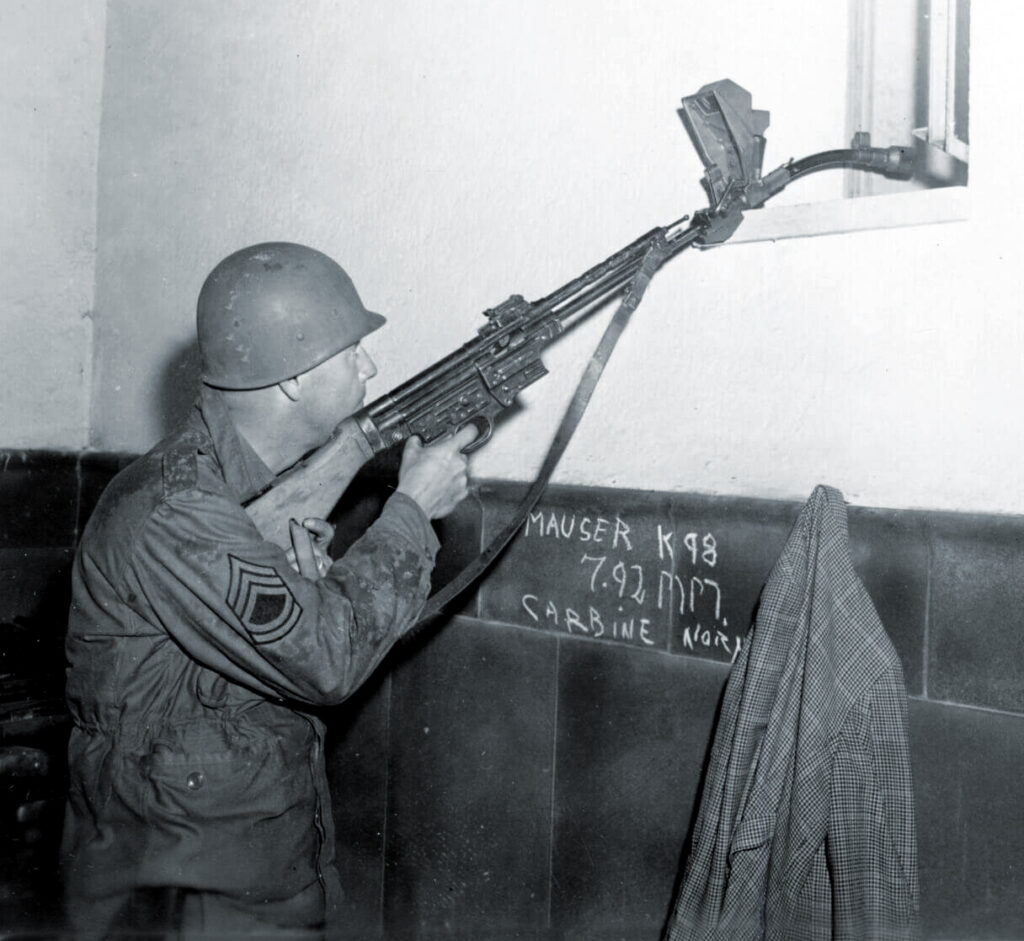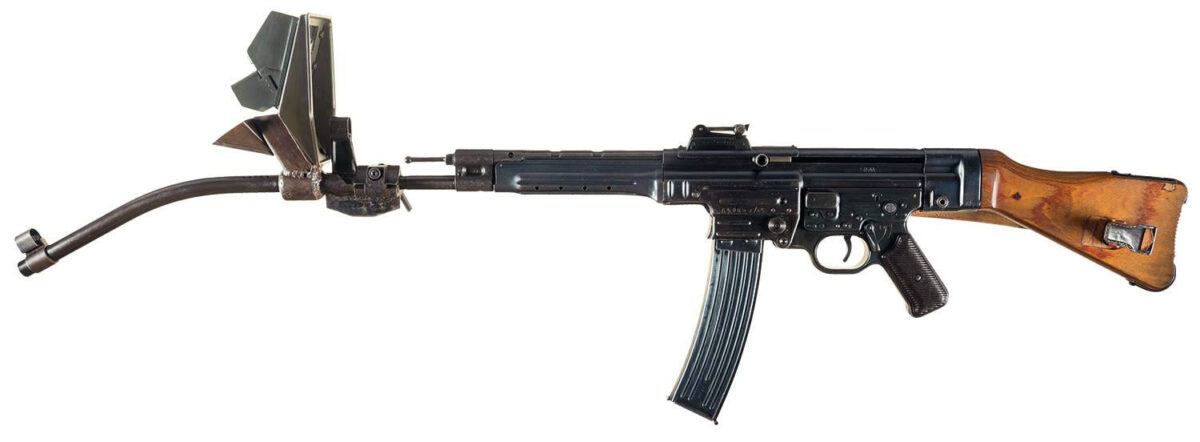German soldiers crouched behind the shattered houses and walls of a Stalingrad suburb. Advancing Soviet soldiers edged closer, covered by a curtain of friendly small-arms and anti-tank fire. Every time a member of the Wehrmacht tried to aim his rifle around a corner, a deadly firestorm greeted him. What was needed was some type of weapon to fire around those corners.
The Stalingrad scenario played out again as the German infantry and tank corps retreated in the face of growing Allied pressure in 1943. They found themselves fighting vicious street battles, and the need for concealed firing was hammered home.
The call for a weapon to allow defensive fire from concealed positions went out to the German arms industry in late 1943. By that time, the Wehrmacht had slowly begun adopting a pair of automatic weapons as standard issue for its troops. The basic Mauser 98k bolt-action 7.92mm rifle had been an excellent infantry weapon during the war’s early stages, but it lacked firepower. The two new weapons were the Maschinenpistole 43 (MP.43), known to GIs as the “burp gun,” and the Gewehr 43 (G.43). There remained the problem of modifying these automatic weapons to fire around corners.
The dilemma was solved by an officer from armaments minister Albert Speer’s technical office. Colonel Hans-Joachim Schaede had worked on a bent-barrel design to offer better protection to mobile, self-propelled artillery. The assault guns (Sturmgeschutz) had been particularly vulnerable during street fighting in Russia. Lacking adequate small-arms firepower, the Sturmgeschutz became an easy target for Russian anti-tank teams. Schaede’s invention, dubbed the Krummer Lauf (bent barrel), met with Adolf Hitler’s approval in December 1943.
Schaede had enjoyed distinguished civilian and military careers. As a businessman, he had parlayed his father’s washing machine factory into a successful enterprise. By the late 1930s, his businesses in Saalfield, Germany, employed more than 500 people. Schaede had gained wartime experience as a lieutenant in an observation balloon platoon during the Great War. A reserve officer, he was called to active duty as a captain in the 1st Panzer Division on August 1, 1939. When war erupted a month later, his division rumbled into Poland. His genius, however, lay in armaments development, and in 1942 he was reassigned as a major to the Munitions-Ministerium. His work on tank improvements won him a 50,000-reichsmark award presented to him by Hitler on October 26, 1942.
By autumn 1943, Schaede had turned his talents to the Krummer Lauf. In cooperation with the Rhein-metall-Borsig (RmB) firm, Schaede began experimenting with the device for use with both 7.92-by-57mm and 7.92-by-33mm cartridges. After extensive tests, it was determined that the greater powder charge of the longer cartridge increased the velocity and pressure to such a degree that the bent barrel wore out after about 100 rounds. The decision was made to adapt the barrel to the shorter-chambered MP.43.
Surprisingly, Hitler took an immense interest in the Krummer Lauf. Only a few months earlier, he had spurned the idea of machine guns as standard equipment for all infantry men. Hitler had been “almost completely convinced that the rifle suits the purpose better,” noted Albert Speer in his memoirs. Perhaps the Führer was now aware of the savagery of the fighting in Russia. Soviet artillery and rocket fire pinned the Wehrmacht and panzers down while the Red Army scrambled forward. “The enemy suffered enormous casualties from our barrage,” noted a Russian officer. “Our infantry swiftly advanced through the enemy front lines. At every step there were blackened German bodies, wrecked enemy guns and mortars, shattered dugouts and pillboxes.” In the house-to-house fighting, the need for concealed firing became very evident. “Whoever stuck his head out or ran across the street was inevitably shot by a sniper or tommygunner,” recalled Marshal V.I. Chuikov of the Stalingrad defenses.

Schaede’s Krummer Lauf device featured a special clamping apparatus that enabled the barrel to be fitted to the MP.43 muzzle and bolted into place. Relatively heavy and unwieldy, the first Krummer Lauf design sported an actual barrel length of nearly 19 inches. The barrel’s diameter was just under an inch, bored and rifled in standard armory fashion, then cold-bent to a 90-degree angle. These original versions initially appeared without sights.
With the backing of Albert Speer, Schaede and a Professor Wenniger of the RmB firm demonstrated the invention to officers of the weapons division on July 6, 1944. Because of the weapon’s heavy recoil, the Krummer Lauf appeared destined for use on panzers and self-propelled guns, where the vehicle’s superstructure could be utilized for firing stability. Unfortunately, the added length of the Krummer Lauf and its recoil made it a cumbersome weapon for infantry use. The demonstration, however, proved a success, and in August 10,000 Krummer Lauf devices were ordered for combat.
The Krummer Lauf won immediate praise from tank crews, who used it to fight off anti-tank squads, particularly on the Eastern Front. Crewmen no longer had to expose themselves to enemy fire to clear away attackers. By September, an additional 20,000 Krummer Lauf attachments per month were ordered for panzer use. In November 1944, Schaede was promoted to colonel and awarded the Knight’s Cross to the War Service Cross with Swords for his work on tank development and his invention of the bent-barrel design.
The notion of a Krummer Lauf for infantry use still plagued Schaede. He developed an 11-inch-barrel model that featured a lesser bend. Only .787 inches in diameter, the infantry model barrel was bored and rifled, then cold-bent to a 30-degree downward angle. The new design also featured an adapter so that a special grenade launcher could be used.
Schaede next turned his attention to a sighting apparatus for the Wehrmacht. The famed Zeiss optical firm helped develop a prismatic visor/sight. A special set of mirrors in the angled visor could be aligned with the iron sight near the muzzle to allow the shooter to accurately fire around a corner. The reduced recoil of the 30-degree Krummer Lauf, coupled with the Zeiss sight, enabled the bent barrel to be used more easily by the infantry. Production on the new model began in early 1945.
The addition of the Krummer Lauf to the Nazi arsenal proved to be far too little and much too late. By the time the new weapon was ready for production, Allied planes ruled the skies, relentlessly bombing remaining German industrial centers. While factory output continued to be fairly stable, the difficulty lay in transporting weapons and munitions to front-line troops. The German rail system had been severely crippled, and there were shortages of trucks and fuel.
Besides the original order for 10,000 Krummer Lauf attachments placed in December 1943, an additional 20,000 of the 90-degree models were ordered per month beginning in September 1944. Thirty thousand 30-degree bent barrels were ordered for infantry use in January 1945, along with an equal number of Zeiss prismatic sights. The Krummer Lauf orders simply outstripped the Reich’s ability to manufacture them. Firearms historian Michael Marine estimates that about 10,000 bent barrels were actually produced, with about 5,000 ticketed for the Wehrmacht. Of those, he suggests, probably 4,000 were delivered to troops fighting the Russians.
Several Krummer Lauf devices were captured by American and British forces during the last battles of the war. Captain Philip B. Sharpe of the U.S. Army Ordnance Corps tested the 90-degree model. “Over two-thirds of the bullets were torn into two or three pieces—but at very short range it would have been deadly,” Sharpe wrote after the war. “When fired from the hip as an ‘around-the-corner-gun,’ not more than three shots could be fired in one burst—it would spin the shooter 90 degrees in three shots—a vicious attachment.” Sharpe also noted that when mounted on a tank, the Krummer Lauf “shot excellently.”
The Germans intended to eventually arm every soldier with a submachine gun outfitted with a 30-degree bent barrel and Zeiss sight. The combination of the machine pistol’s firepower and the Krummer Lauf’s around-the-corner capability would have been devastating in European street fighting. In testing the 30-degree model, Captain Sharpe observed that it “shot perfectly. At 100 meters this author could place four out of five shots in a letterhead size target….Had these [Krummer Lauf devices] ever gotten into full production and distribution, they would have cost us many thousands of casualties.”
The Krummer Lauf attachment could not stem the sweeping tide of the Soviets in the east or the advancing Allies from the west. Variations of the bent barrels were on the drawing tables for fitting to other German weapons. A 40-degree-bend Krummer Lauf was developed, but never made it past the experimental stage.
Like many thousands of German soldiers, Colonel Hans Joachim Schaede was captured by the Soviets at war’s end. Sent to various prisons in the Soviet Union, he was specifically targeted by their military courts for his efforts on tank development and the creation of the Krummer Lauf. In 1953, he was finally released and returned to a quiet life in Germany. Schaede died in 1967.





